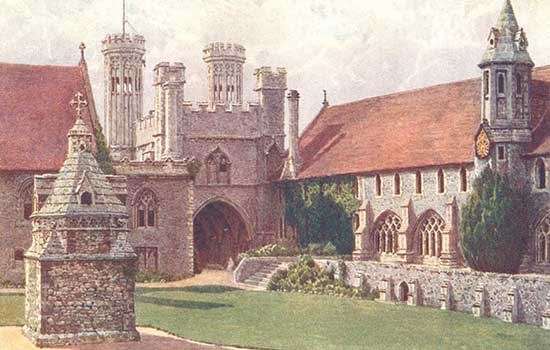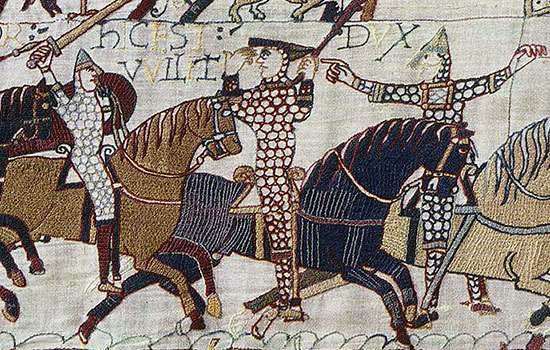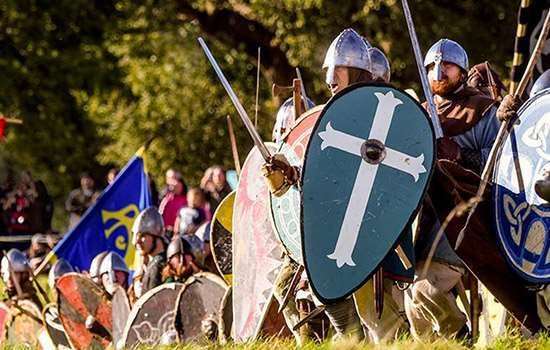A Papal Mission
Almost nothing is known of the early life of the man who brought Christianity to medieval England. Augustine was most likely living as a monk in Rome when in 595, Pope Gregory the Great chose him to lead a mission to convert the pagan Anglo-Saxons to the Christian faith. Christianity had been present in England during Roman times, but with the arrival of the Saxons, most of the country had once again reverted to paganism.
England in the 6th century was divided into many warring kingdoms. Of these, it was Kent that was chosen as the place to begin Augustine’s mission in England, most likely because of the powerful position of its ruler, King Æthelberht.
A Legendary Meeting
The story of St Augustine’s arrival in England has become the stuff of legend, and was first told by the 8th-century monk and historian Bede, writing 140 years after the events took place. Bede describes how when Augustine arrived in Kent, Æthelberht met the monk and his 40 companions outdoors, because the pagan king was scared of the new arrivals practising sorcery.
The monks are said to have held up a silver cross and a panel painted with the image of Christ. We are told that King Æthelberht, while wary of his visitors, did allow them to preach to the gathering. The exact location of these events is not known, but in the 19th century, Granville George Leveson-Gower, 2nd Earl Granville, erected a stone cross near Ramsgate, on the site where, local legend had it, this first meeting took place.
Read more about the history of St Augustine’s CrossQueen Bertha
King Æthelberht was most likely accompanied by his wife, Queen Bertha. Bertha was a Frankish princess who was already a Christian, despite her marriage to a pagan king. It is thought that the presence of Bertha may have been another reason for Augustine to begin his mission in Kent. She is known to have been in contact with the Pope around this time, and the fact that her husband allowed her to practise Christianity perhaps suggested that he might also be sympathetic to Augustine’s mission.
King Æthelberht did not immediately convert to Christianity, but he did treat Augustine and his companions with hospitality. They were given freedom to preach and invited to reside in Canterbury, the capital of Kent. Augustine and his companions held services in the ancient church of St Martin’s, which is believed to be the church that Queen Bertha herself worshipped in.
Eventually, King Æthelberht did convert, and the abbey of St Peter and Paul (later rededicated to St Augustine) was founded in Canterbury in about 598. Augustine became the first Archbishop of Canterbury, a role that to this day is still the most senior cleric in the Church of England.
Read more about Queen BerthaRoyal Patronage
There were many advantages for Augustine in gaining royal support for his mission. King Æthelbert’s gifts enabled the creation of a school and a library at the abbey, which in turn established it as an important seat of learning. Pope Gregory even sent books from Rome to fill the abbey’s bookshelves.
Æthelberht also provided protection to the new Christian church. He made laws that protected church property and punished transgressions against the Church even more harshly than those against the Crown. These charters may have been drawn up under the guidance of Augustine himself. Augustine was clearly a shrewd man who knew that royal support was essential if his mission was to be successful.
Augustine’s Legacy
It is known that Augustine died on 26 May, though scholars still argue over whether the year was 604 or perhaps 609. Christianity continued to spread throughout the other English kingdoms in the years that followed St Augustine’s first mission, but its progression was not smooth. Not all of the successors to the converted Anglo-Saxon kings were Christian, including some of those that followed Æthelberht in Kent. The Christianisation of the Anglo-Saxon kingdoms was finally completed at the end of the 7th century, when the Isle of Wight’s last pagan king, Aruald, died in 686.
St Augustine’s Abbey became one of the most important Benedictine monasteries in the medieval world, and was a thriving centre of learning and culture for almost 1,000 years before its suppression in 1538. It is the burial place of several Anglo-Saxon kings and Archbishops of Canterbury, including St Augustine himself, and today forms part of a UNESCO World Heritage Site.
Learn more about the history of St Augustine’s AbbeyRead more
-

History of St Augustine's Abbey
Learn about the fascinating history of St Augustine’s Abbey, from its monastic golden age to its later existence as home to a royal palace, poorhouse and school.
-

What happened at the Battle of Hastings?
At dawn on Saturday 14 October 1066, two great armies prepared to fight for the throne of England. Read what happened at the most famous battle in English history.
-

1066 and the Norman Conquest
Find out much more about the events of 1066, and discover where to find some of the most spectacular castles and abbeys the Normans built across England.
